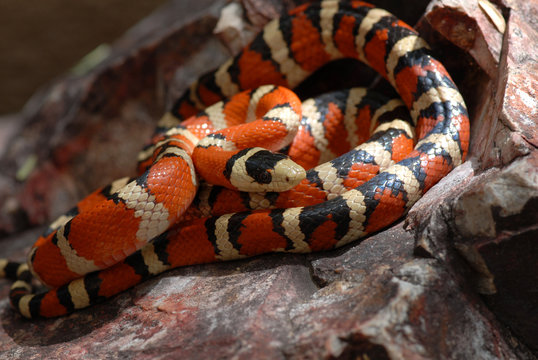ANIMAL: Arizona Mountain Kingsnake Lampropeltis pyromelana Type of Animal: Colubrid Habitat: Mountainous areas from 3,000-9,000 ft-rocky mountainous areas, conifer forest, heavily wooded rocky slopes, steep canyon bottoms w/ abundant leaf litter/fallen logs/rocks, chaparral, open rolling hills, grassland, woodland, streams/streamsides, springs, rock piles at woodland edges near water, riversides, forests along streams, rocky forest, ponderosa pine forest, pine-fir belts Location(s): Arizona, Utah, Nevada, extreme SW New Mexico, N Mexico Appearance: Small slender species, red body w/ white/yellow-white rings bordered by thin black & wide red sections, white/yellow snout, head black on top (sometimes w/ red flashing over eyes), large eyes, Utah subspecies darker than nominate Arizona subspecies & have more black rings as well as whiter face w/ distinct black mask, look similar to venomous Arizona Coral Snake but have less yellow than that species Food/Diet: Lizards, other snakes (including each other & venomous snakes), rodents, birds, bats, eggs, amphibians Status in Wild: Stable Conservation: Breeding in zoos, wildlife centers, & herpetoculture Lifestyle: Solitary Additional Info: Called: Male Female Young: Snakelet Group: Solitary Weight: Male: 2.08 oz Female: 2.38 oz Gestation: 3 months Life Span: 12-20 years Body Length: Male: 2.9 ft Female: 3.6 ft Young: 1 ft Tail Length: Male: 0.7 ft Female: 0.4 ft Main predators are raptors, roadrunners, mammals, & larger snakes. These nonvenomous snakes kill prey by constriction. Sexually mature at a year old. Also called Sonoran Mountain Kingsnake and/or Utah Mountain Kingsnake. These snakes rather shy in wild. While primarily terrestrial, they’re great climbers. Most often diurnal but will come out on moister nights. They hibernate in colder weather. Females lay clutches of 3-20 eggs. Juveniles shed more often than adults. Breed in late spring w/ eggs hatching in late summer. When they hatch, they’re immediately on their own. Fun Fact(s): Often mimic patterns of highly venomous Arizona Coral Snake to deter predators-this species red bands bordered by black (Red On Black, Friend of Jack) while Coral Snake has red bands bordered w/ white/yellow (Red On Yellow, Kill That Fellow). Name “king” comes from habit of eating other snakes. Almost impervious to snake venom. These snakes tend to be very docile in captivity making decent pets. While fairly docile, these snakes will bite & discharge musk/feces when threatened.
